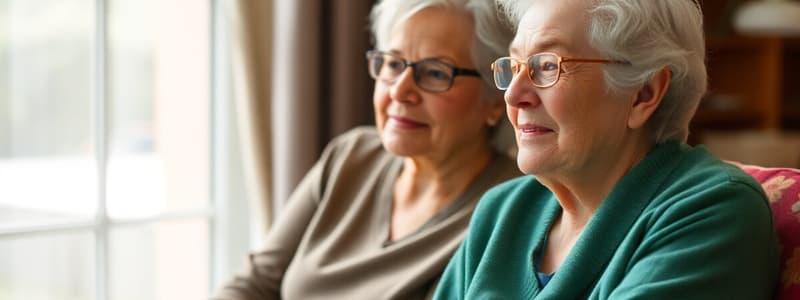Podcast
Questions and Answers
What is a likely impact of high divorce and re-marriage rates on family structures?
What is a likely impact of high divorce and re-marriage rates on family structures?
- Decrease in the number of extended families
- Increase in households with blended families (correct)
- Increase in single-parent households
- Reduction in multigenerational living arrangements
What is a significant reason for the difference in widowhood rates between men and women over age 65?
What is a significant reason for the difference in widowhood rates between men and women over age 65?
- Women are less likely to remarry compared to men (correct)
- Men are more likely to live independently after losing a partner
- Men have a longer life expectancy than women
- Women experience less grief and emotional distress
Which dimension of grief reactions includes feelings of sadness and irritability?
Which dimension of grief reactions includes feelings of sadness and irritability?
- Physiological / Somatic
- Affective (correct)
- Cognitive
- Behavioural
What challenge do 2SLGBTQI+ older adults often face concerning their sexual orientation?
What challenge do 2SLGBTQI+ older adults often face concerning their sexual orientation?
What is a potential consequence of multigenerational family structures becoming more common?
What is a potential consequence of multigenerational family structures becoming more common?
What is a common developmental transition that old adults may experience?
What is a common developmental transition that old adults may experience?
Which type of transition is characterized by expected changes in life roles and responsibilities?
Which type of transition is characterized by expected changes in life roles and responsibilities?
What can contribute to a transitional crisis during significant life changes for older adults?
What can contribute to a transitional crisis during significant life changes for older adults?
How can the timing of a partner's death influence an individual’s widowhood experience?
How can the timing of a partner's death influence an individual’s widowhood experience?
What challenge might arise from changing family structures in older adults?
What challenge might arise from changing family structures in older adults?
In what way may divorce impact older adults differently compared to younger individuals?
In what way may divorce impact older adults differently compared to younger individuals?
Which factor typically contributes to a smoother transition during life changes for older adults?
Which factor typically contributes to a smoother transition during life changes for older adults?
What is a common barrier to adapting to a significant life transition, such as retirement?
What is a common barrier to adapting to a significant life transition, such as retirement?
What are the three pillars of financial security in retirement?
What are the three pillars of financial security in retirement?
Which group is most likely to have access to retirement planning education?
Which group is most likely to have access to retirement planning education?
How has the perception of divorce among older adults changed recently?
How has the perception of divorce among older adults changed recently?
Which type of family structure is not mentioned as impacting older adults as they age?
Which type of family structure is not mentioned as impacting older adults as they age?
What percentage of today's families are couples without children?
What percentage of today's families are couples without children?
What is a potential consequence of inadequate retirement planning education?
What is a potential consequence of inadequate retirement planning education?
Why might marital breakdown be particularly challenging for older adults?
Why might marital breakdown be particularly challenging for older adults?
What role can grandparents play in modern family structures?
What role can grandparents play in modern family structures?
Flashcards
Retirement Planning Importance
Retirement Planning Importance
Planning for retirement is crucial to ensure a comfortable financial future.
Retirement Program Bias
Retirement Program Bias
Retirement programs often target higher-educated, higher-income, or government employees, creating an inequality in access to knowledge and preparation.
Retirement Pillars
Retirement Pillars
Three key sources of retirement security: OAS/GAINS, CPP, and private savings (RRSPs, etc.).
Divorce in Old Age
Divorce in Old Age
Signup and view all the flashcards
Changing Families
Changing Families
Signup and view all the flashcards
Couples Without Children
Couples Without Children
Signup and view all the flashcards
Blended Families
Blended Families
Signup and view all the flashcards
Multigenerational Families
Multigenerational Families
Signup and view all the flashcards
Widowhood
Widowhood
Signup and view all the flashcards
Grief Reactions (Dimensions)
Grief Reactions (Dimensions)
Signup and view all the flashcards
2SLGBTQI+ Older Adults
2SLGBTQI+ Older Adults
Signup and view all the flashcards
Transition
Transition
Signup and view all the flashcards
Developmental Transition
Developmental Transition
Signup and view all the flashcards
Situational Transition
Situational Transition
Signup and view all the flashcards
Health-Illness Transition
Health-Illness Transition
Signup and view all the flashcards
Transitional Crisis
Transitional Crisis
Signup and view all the flashcards
Sudden Transition
Sudden Transition
Signup and view all the flashcards
Loss-related Transition
Loss-related Transition
Signup and view all the flashcards
Study Notes
Week 3: Transitions, Family Relationships & Home Assessment
- Copyright: This presentation and all its content are the copyright and property of Durham College or its Licensors (2022).
Learning Objectives
- Describe various theoretical perspectives on aging (social, psychological, spiritual, and cognitive).
- Identify key transitions in the life of an older adult.
- Identify how relationships and roles change as an adult ages.
- Discuss issues related to sexuality and intimacy for older adults.
- Identify home hazards for older adults.
- Participate in a virtual simulation experience focusing on client safety, communication, relationships, and community resources for older adults in the Durham Region.
Transitions
- Transition: A process of redefining self and developing agency in response to life events. Moving through these transitions is normal for older adults.
- Developmental Transitions: Retirement, becoming grandparents, situational transitions (widowhood, becoming a caregiver, moving to a senior's residence or downsizing)
- Health-Illness Transitions: Chronic illness, transition between hospital and home, or home to long-term care.
- Transitions can be planned (retirement, moving) or sudden and surprising (widowhood, new diagnosis).
- The speed and intensity of a transition, as well as whether it's anticipated, can affect the transition process.
- It can lead to a transitional crisis or a gradual, controlled adaptation.
Factors that Influence Transitions (Resulting From Loss)
- Personal meaning, Socioeconomic status, Expectations, Knowledge, Emotional reserve, Physical reserve, Planning, Community & Social Conditions.
- The ideal transition involves more gains than losses. Difficult transitions involve more losses than gains.
Retirement
- Historically, retirement lasted a few years between work and death.
- Now, with longer lifespans, retirement could last 30 years or more.
- The federal government estimates that approximately 24% of older adults may not have sufficient income to maintain their standard of living upon retirement.
- Health, income, and social environment influence how successfully individuals transition to retirement.
- People are living longer and seeking employment to support themselves financially after retirement.
Retirement Planning
- Important to plan for retirement.
- Most retirement programs target employees with high levels of education, occupation, or government employment.
- This creates inequities as people age, as those with fewer resources often need more support for retirement planning. Three pillars of financial security are: (1) Federal Old Age Security and Guaranteed Income Supplement. (2) Canada Pension Plan. (3) Private Savings/RRSPs/Pension Plans.
Divorce
- Historically, divorce was considered a stigmatizing event, potentially not discussed due to the stigma associated with it.
- A current trend is that older couples are less likely to stay in unsatisfying marriages.
- Marital breakdowns can be particularly devastating in old age due to their often unanticipated nature.
Relationships
- In Canada, there is no longer a "typical family"; multiple structures and situations exist.
- Discuss how the various factors involved in relationship structures and compositions can impact older adults.
- Examples include: Individuals or couples without children, Divorced older adults, Blended families, Multigenerational families, Grandparents with formal and informal parental roles.
- As families change, the roles and expectations of family members also change. Important to note that 38% of today's families are couples without children. Changes to family structures may include high divorce and re-marriage rates, resulting in blended families with children from previous and new marriages. Multigenerational families are becoming more common.
Widowhood
- 34% of women and 11% of men aged 65 and older are widowed. The rate is lower for men due to men being more likely to remarry.
- Losing a partner after a long, satisfying relationship is a significant life transition.
- Four dimensions of grief reactions: Affective (depression, anxiety, anger, irritability), Cognitive (thoughts of deceased, helplessness), Behavioral (agitation, fatigue, social withdrawal), and Physiological (loss of appetite, energy loss).
2SLGBTQI+ Older Adults
- Less than 1% of Canadians aged 65 and older are in same-sex partnerships.
- These relationships will become more common in future generations.
- Longstanding discrimination and fear may prevent LGBTQ individuals from disclosing their sexual orientation, gender identity, or relationships to healthcare providers.
- Many LGBTQ individuals have non-relatives who become family
Intimacy
- Intimacy is a "warm, meaningful feeling of joy" (Boscart et al., 2023) involving close friendships, family relationships, and knowing one matters to others.
- Components of intimacy include commitment, affective intimacy, cognitive intimacy, physical intimacy, and interdependence.
Sexual Health
- Reflect on societal beliefs about sexuality and aging.
- Sexuality is a central aspect of being human throughout the lifespan, encompassing sex, gender, identities, gender roles, sexual orientations, eroticism, pleasure, intimacy, and reproduction (WHO).
- Despite a positive definition of sexuality, significant stereotypes and stigma remain.
Sexuality & Intimacy in Long-Term Care (LTC)
- As dementia progresses, intimacy and sexuality issues may present challenges.
- Determining a cognitively impaired person's ability to consent to sexual activity involves assessing mental capacity, risks and benefits, and voluntary participation.
- LTC homes have a duty to protect residents from abuse and harm if they lack the capacity to consent to sexual activity.
Nurses' Role
- Older adults dating and having new partners are at high risk.
- Nurses play a crucial role in education and counselling about sexual function, adapting to age-related changes, and promoting open conversations about sexual needs.
- Nurses should be comfortable taking a complete sexual history and providing education about STIs and safe sex practices.
Stats
- Some statistics about Americans having better health and active aging.
Types of Caregiving
- Spousal Caregiving, Aging parents caring for developmentally disabled children, Grandparents raising grandchildren, Long-distance caregiving.
Caring for Older Adults
- Many adult children take on caregiving roles for aging parents.
- Factors that increase the likelihood of being a caregiver include being the closest female relative, having friends or family with medical, financial or legal expertise, being from a financially successful/resourceful family, or part of a community with cultural expectations of caring for elders.
Caring for the Caregiver
- Caregivers must balance work, family, and caregiving responsibilities.
- Nurses should support caregivers by offering resources, education, and listening/emotional support, for both emotional and physical well-being.
DC Connect 3.3 Video
- Watch video and answer questions.
Home Assessment
- Go to DC Connect Module 3.4 for the home assessment.
Studying That Suits You
Use AI to generate personalized quizzes and flashcards to suit your learning preferences.




